Food plays such an enormous role in Mexican culture that the cuisine even got a major nod from UNESCO in 2010, when it was added to the Intangible Cultural Heritage List—the food version of a World Heritage site. Traditional Mexican cuisine’s roots lie deep in Mesoamerica and over centuries has seen influence from Spanish conquistadors, the Atlantic slave trade, and waves of immigration big and small from China, Italy, Germany, France, and most of all, Lebanon. This list of essential Mexican foods is by no means exhaustive but covers 14 dishes to try, from the lesser-known green chorizo to two stand-out varieties of tacos. ¡Buen provecho!
Chicharrón prensado
- Region of origin: Oaxaca
- Where to try it: Memelas y Emanadas CLAU and Antojitos Raúl in Oaxaca; Etnia Cocina de Pueblo in Tijuana
Chicharron prensado is crunchy pork skin that’s been pressed in a cloth to squeeze out the juices. It’s often served in a gordita, and you may be able to find it at a gorditas stand near the entrance to the excellent Tlacolula Sunday market, in Oaxaca (a must when you’re in town). It’s a dish that originates in Oaxaca but its success has crossed all regional lines, and now you’ll find it practically everywhere in Mexico, from street stalls to sit-down restaurants.
Pambazo

The pambazo starts with a roll dipped in red guajillo sauce.
Photo by Jack7_7/Shutterstock
- Region of origin: Mexico City
- Where to try it: El Pambazo Loco
When it comes to Mexican sandwiches, tortas are just the tip of the iceberg. Enter the pambazo, whose soft bread roll has been soaked in red guajillo pepper salsa until it gets completely soggy, then griddled until warm and crispy on both sides. The sandwich is filled (often to bursting) with sautéed chorizo and potatoes and garnished with shredded lettuce, salsa, crumbled queso fresco, and crema. It’s definitely a hearty dish to keep you going as you pound the pavement in Mexico City, where you’ll find it at many street stands; keep your eyes peeled for sandwiches on red-tinted bread.
Costras
- Region of origin: Mexico City
- Where to try it: Las Costras De La Roma; El Farolito (multiple locations); Las Costras
The costra is a genius invention: It’s essentially a tortilla made of crispy cheese. Like many of the world’s best foods, costras were first served to the late-night crowd, outside of a nightclub in Mexico City. The word means “scab” or “crust” in Spanish, and indeed it’s an extremely delicious crispy cheese crust. The cook takes shredded white cheese, often Oaxacan-style, and spreads it in a mound on the griddle until it melts into a cheese pancake, crispy and browned. It’s then scraped off the griddle in one piece, and wrapped around whatever fillings you’ve asked for, just like a tortilla. Everyone is obsessed with the original Mexico City stand, aptly called Las Costras, but you can also find good ones at the various (more convenient) outposts of El Farolito.
Tepache

A refreshing glass of tepache helps cut the fat of some taco meats.
Photo by Guajillo studio/Shutterstock
- Region of origin: Tlaxcala
- Where to try it: Tacos Borrego Viudo in Mexico City
A fermented beverage made with water and pineapple rind, plus piloncillo, a flavorful unrefined sugar, tepache—like kombucha—has a teeny, tiny bit of alcohol. The taste is sweet, sour, and deeply earthy, indeed a little like kombucha, and it’s super refreshing on a hot day. You can find it at street stands around the entire country and sometimes at taquerías, where the tepache helps cut through the grease of fatty fillings like steamed tripe.
Tikin xic
- Region or origin: Yucatán
- Where to try it: El Camello Jr. in Tulum; Tikinxic II in Mérida
The Yucatán has given many beautiful foods to the world, including its version of barbecued pork, cochinita pibil. Another is tikin xic (pronounced “teekeen sheek”), a preparation usually applied to seafood that goes back to the region’s Indigenous Maya people. Tikin xic’s key ingredient is the achiote seed, aka annatto, which gives it a bright red color; the other ingredients usually include garlic, chilies, citrus juice, and spices like cumin and cloves. Fish or any seafood is rubbed with this delicious paste, steamed in banana leaves, and served as a tidy little packet to open like the gift that it is.
Chicharrón preparado

Chicharrón preparado is a greasy, messy snack that you might have to tackle with your hands.
Photo by Guajillo studio/Shutterstock
- Region of origin: Mexico City
- Where to try it: Señor Chicharrón in Mexico City
This delightful (very vegetarian unfriendly) snack is not to be confused with chicharrón prensado. The two have little in common aside from the fried pork skin factor. It resembles a pizza, with a deep-fried rectangle of chicharrón as the base. The fatty cracker is piled with cabbage, tomato, avocado, lots of crema, hot sauce, and gelatinous strips of pickled pork rind (it’s good, trust us). It’s not the most common dish, but if you sniff around street stalls and snack bars, you may run across it.
Garnachas

Garnachas tick all the boxes when it comes to salt, fat, acid, and heat.
Photo by xhico/Shutterstock
- Region of origin: Oaxaca
- Where to try it: Le Teca and Zandunga Sabor Istmeño, both in Oaxaca
Garnacha can refer to several different things in Mexico, including the general family of griddled corn-based snacks such as sopes. But in Oaxaca, it means one thing: a small lard-fried disk of masa topped with stewed shredded meat, queso fresco, salsa, and a vinegary cabbage slaw. The dish originates in an area called El Istmo de Oaxaca, a region in states Oaxaca and Veracruz that stretches the Gulf of Mexico to the Pacific, and is a prime example of Istmeño cuisine.
Green chorizo
- Region of origin: Toluca
- Where to try it: Ricos Tacos Toluca in Mexico City
Green chorizo, which originates in the tiny state of Toluca, about an hour’s drive from Mexico City, gets its color from a mix of parsley, cilantro, and green-colored chilies (serranos and poblanos), and the color is really vibrant. Order it in a taco, then top it with guacamole, grilled onions, cheese, and even fries. The restaurant Ricos Tacos Toluca has four superb house-made salsas, but note that two are very spicy.
Tlyaudas
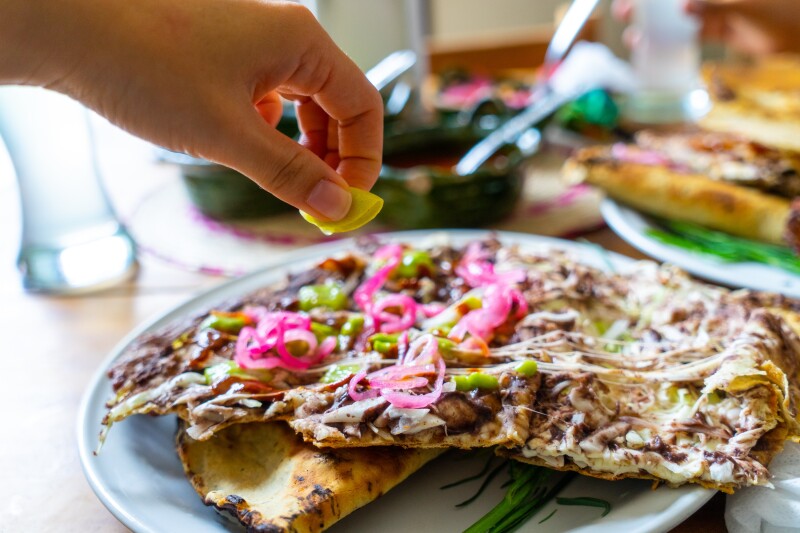
Be sure to squeeze a lime on your tlayuda before tucking in.
aindigo/Shutterstock
- Region of origin: Oaxaca
- Where to try it: Las Tlayudas Antojería Oaxaqueña in Oaxaca
Tlayudas are a popular Oaxacan antojito (literally “little cravings”). An open-faced tortilla (usually toasted or pan-fried) serves as the perfect vehicle for an assortment of toppings: meats like carne asada and chicharrón; spreads of refried beans; vegetables like lettuce, cabbage, and avocado; various salsas; and, of course, melted Oaxacan cheese. Colloquially known as “Oaxacan pizza,” these crunchy snacks are a treat not to be missed.
Enchiladas
- Region of origin: Varies depending on the type of enchilada
- Where to try it: El Cardenal in Mexico City
Red and green enchiladas are a Tex-Mex favorite in the USA, but the variety you find across Mexico is impressive. In Colima, for example, you’ll find enchiladas dulces, whose mole is sweetened with piloncillo (unrefined cane sugar) and raisins. The enchiladas potosinas from San Luis Potosí have small red tortillas (chili is added to the nixtamal, or processed corn flour) and are filled with cheese and hot sauce, then served with the usual beans, avocado, and crema.
Mole
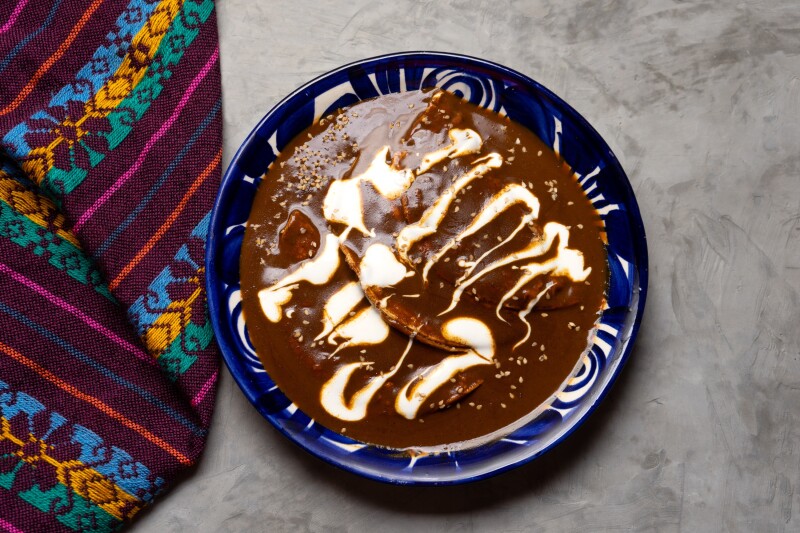
There are chicken enchiladas (enmoladas) hiding under this silky mole
Photo by Guajillo studio/Shutterstock
- Region of origin: Puebla and Oaxaca
- Where to try it: Augurio in Puebla
Mole is one of Mexico’s most distinctive creations. The thick, dark, dense sauce is made from a variety of Mexican chilies, spices like coriander and allspice, and cocoa. The flavor is spicy, smokey, earthy, and a tiny bit sweet from the cocoa. You’ll find mole often used to coat chicken or pork dishes, including enchiladas.
Chapulines
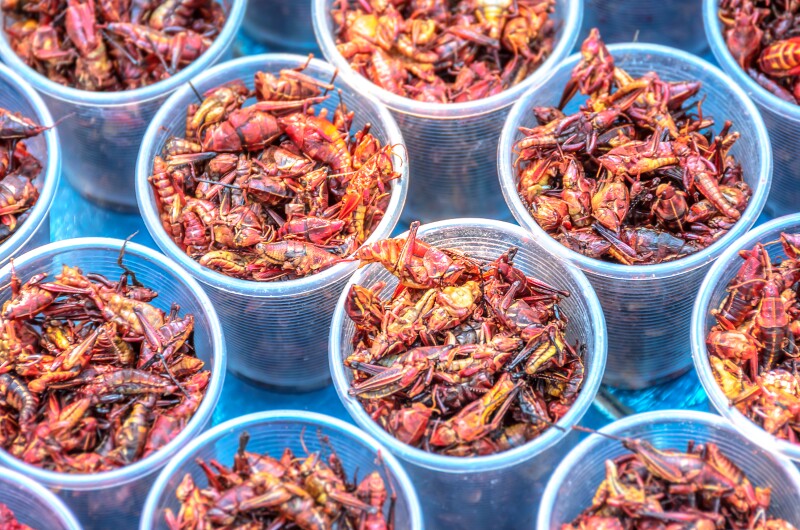
Salty, crunchy fried grasshoppers go well with a cold beer.
Photo by AGCuesta/Shutterstock
- Region of origin: Oaxaca
- Where to try it: Tacos de cazuela del Carmen alto in Oaxaca; La Casa de Los Tacos Coyoacán in Mexico City
Keep an open mind when it comes to this beloved Mexican snack, a roasted or sometimes deep-fried grasshopper. You can find them for sale at street stalls and wholesale shops, either on their own or as part of a mix of crispy insects, like chicatanas (toasted ants). If eating chapulines straight up is a bridge too far, try them in a taco.
Tacos árabes
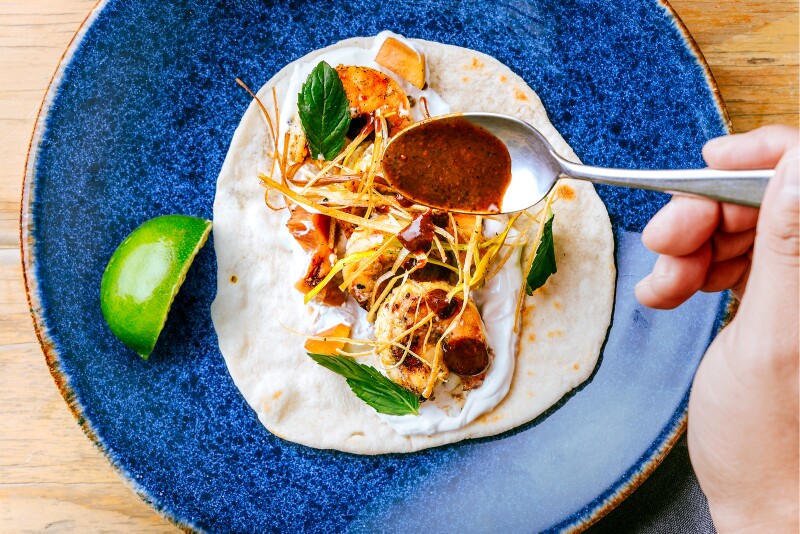
Andrea Sayeg’s Alay Alay dishes up modern tacos árabes
Photo by Jake Naughton
- Region of origin: Puebla
- Where to try it: Taqueria El Greco and Alay Alay in Mexico City and Antigua Taqueria La Oriental (multiple locations around Puebla)
If the trompo (vertical rotisserie) used to roast al pastor–style pork looks like shawarma, you’re not imagining things. During the 19th and early 20th centuries, there were huge waves of Lebanese migration to Mexico, bringing with it this unique style of cooking. If there’s one taco you can reliably find across the entire country, it’s the al pastor, usually served in corn tortillas. However, there’s a less common version known as a taco árabe that’s made with a round piece of flatbread instead, sometimes thin, sometimes closer to a pita.
Baja Fish Tacos
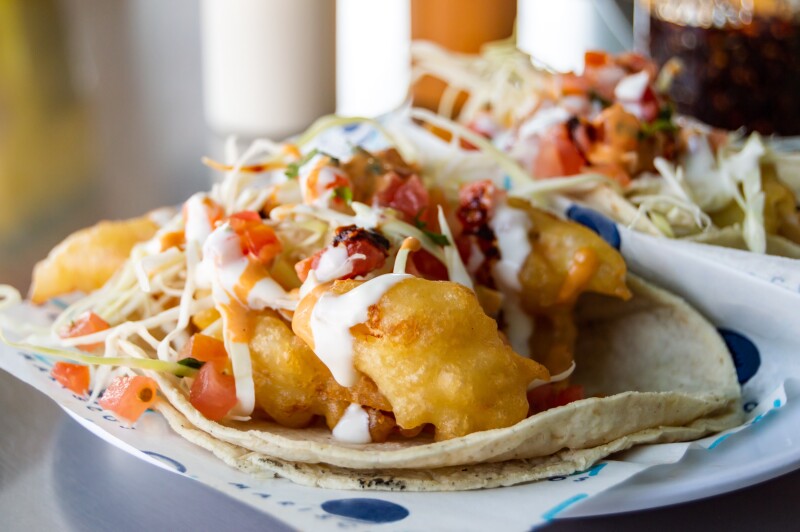
A crispy Baja-style fish taco is best enjoyed near the coast.
Photo by Robert Briggs/Shutterstock
- Region of origin: Baja California
- Where to try it: Tacos de Pescado El Johnny and Tacos Floresta in Ensenada; Tacos de Camaron Entre 3ra y Negrete in Tijuana; Taco Fish la Paz in Guadalajara
A plate of fish tacos eaten by the sea, the breeze salty and humid, the crunch of the beer-batter exterior audible, is a transcendent experience. A classic Baja-style fish taco is a white-fleshed fish battered and fried, topped with shredded cabbage, and sometimes a creamy white sauce. You’ll also find them grilled, sometimes with salsa, but both are elevated with a few squeezes of lime juice.
This article was originally published in 2015 and most recently updated on August 5, 2024, with current information. Jenny Miller and Cat Sposato contributed to the reporting of this story.











